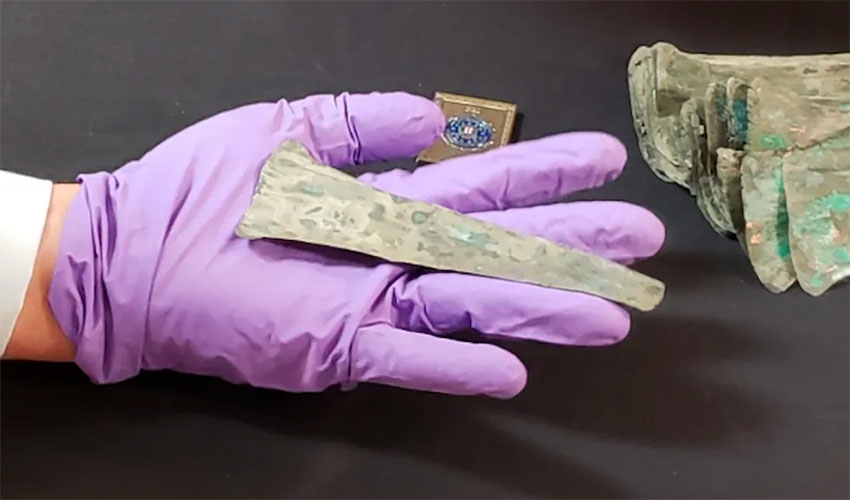The currency was used in Michoacán and Guerrero as far back as 1200 AD
by the El Reportero’s wire service
The United States returned a collection of over 3,500 pre-Hispanic copper coins to Mexican authorities in a ceremony in Miami on Monday.
The coins were used in what are now Michoacán and Guerrero between the years 1200 and 1500, according to Jessica Cascante, spokesperson for the Mexican Consulate in Miami.
A U.S. collector acquired them in Texas at a numismatic fair in the 1960s, she said, but at that time neither Mexico nor the United States was part of a UNESCO convention that guarantees the return of such heritage artifacts to their countries of origin.
Cascante said the fragile, tongue-shaped coins, which are currently covered in verdigris, will be sent to Mexico in January.
Agents of the U.S. Federal Bureau of Investigations (FBI) who headed the operation to recover the coins attended the presentation ceremony along with the Consul General of Mexico in Miami, Jonathan Chait.
Mexican authorities notified the FBI of the existence of the coins in 2013 when they were taken to Spain for an auction. Mexico’s National Institute of Anthropology and History (INAH) then began authenticating the coins in order to request their return.
As both countries were by then signatories to the UNESCO convention (Mexico in 1972 and the United States in 1983), the return process was completed six years later.
Cascante did not divulge the name of the collector who obtained the coins in the 1960s, but said that he did so before it constituted a crime and turned them in voluntarily.
“Now we’re just waiting for the physical material to arrive [in Mexico],” she said, adding that they are currently being packaged with the support of specialists from history museums in Florida.
Source: El Universal (sp)
Argentina issues Treasury Bills, subscribed by the Central bank, to pay creditors
Argentina’s new government announced the issuance of US$ 1.326 billion of dollar-denominated Treasury Bills, to be directly subscribed by the central bank, according to a decree in the Official Gazette on Thursday.
The issuance of the 10-year debt comes as the country’s new Peronist President Alberto Fernandez looks to pay off creditors and stave off a damaging default.
Argentina, hit by a debt crisis since last year, is facing tough restructuring negotiations with creditors including the International Monetary Fund (IMF) over around US$ 100 billion in sovereign debt which it is struggling to service.
The Treasury Bills will expire on Dec. 30 2029 with interest payable semi-annually. The rate will depend on the interest accrued by the central bank’s foreign reserves and capped at the annual LIBOR rate minus one percentage point, the decree said.
A recently passed law to help revive Argentina’s economy, Latin America’s third largest, allows the government to issue up to US$ 4.571 billion in similar dollar denominated bills.
President of Panama denies privatizations in health and water
President of Panama Laurentino Cortizo denied last week the privatization of the Institute of National Aqueducts and Sewers (IDAAN) and the Social Security Fund (CSS).
In statements to the press, Cortizo assured that his administration is working on the transformation and rescue of both public institutions so that they provide an efficient and sustainable service to the population.
Panamanian government agrees to increase wages for banana growers
A resounding triumph is being celebrated by banana growers in Changuinola today, in the northwestern tip of Panama, who suspended an indefinite strike after negotiating a 28 percent staggered salary rise.
The initial demand was for an increase of 25 percent, but during the negotiations they agreed to receive eight percent from Jan. 15, a further 13 percent in 2021 and another 7 percent by 2023, Liberto Becker of the Industrial Union of Banana Workers in Independent Banana Producers, SITRAPBI.
They also agreed that the company would not dock wages for the strike action, while the government committed to the delivery of school and Christmas bonuses, and scholarships for workers’ children.
A presidential decree issued on Tuesday had granted a pay rise of juse eight percent, the highest of those approved for all sectors, but not representing a solution to banana workers’ demands, which saw them continue their strike action until the new deal was reached in the early morning yesterday.
As additional help, the government undertook to build some 1,500 homes for workers, many of whom come from the distant Ngabe Buglé Region and must rent accomodation while they work in the fields, near the border with Costa Rica.
The 7,000 workers of the 29 plantations benefiting from the agreements will receive a visit from the President of the country, Laurentino Cortizo, who promised to continue the dialogue on the concerns and needs of workers and possible solutions, union sources revealed.



